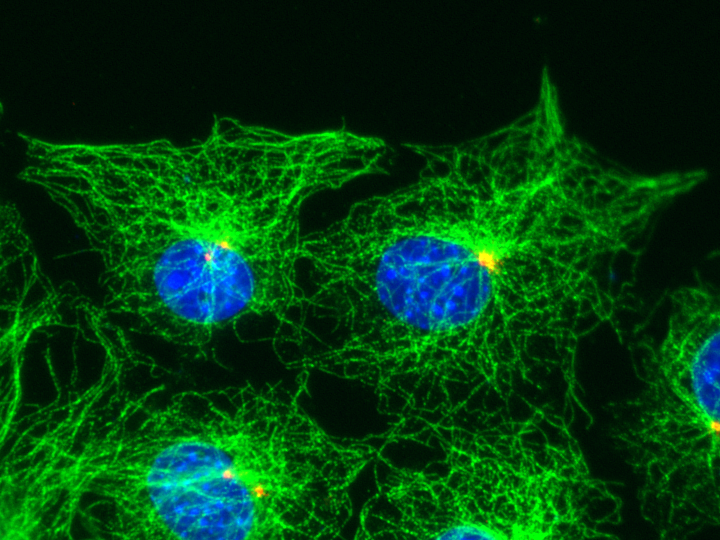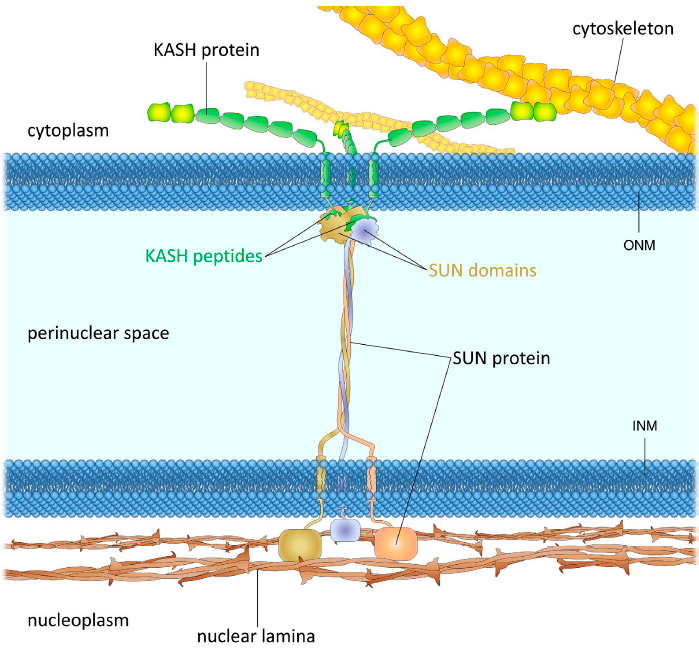 Fibroblasts polarized for migration. Green: anti-tubulin; Red: anit-pericentrin; Blue: DAPI.
Fibroblasts polarized for migration. Green: anti-tubulin; Red: anit-pericentrin; Blue: DAPI.
The nucleus-centrosome axis determines the polarity in migratory cell and nuclear movement is one of the earliest symmetry-breaking processes essential for cell polarization and cell migration. Upon stimulation, cdc42 is activated and subsequently activates actin and myosin to actively move the nucleus rearward and microtubule and dynein to maintain the centrosome at the cell center.
 The LINC complex. , JCB 2015.
The LINC complex. , JCB 2015.
The cytoskeletal elements are coupled to the nucleus though the linker of nucleoskeleton and cytoskeleton (LINC) complexes, which are composed of nesprin proteins on the outer nuclear membrane and SUN domain proteins on the inner nuclear membrane. Nesprins binds to cytoskeleton and SUN proteins are anchored to the nuclear lamina, a meshwork of lamin proteins underneath the nuclear envelope. These nuclear envelope proteins are not merely downstream factors of the cytoskeletal movement. they also play important roles in regulating the cytoskeleton as well as mechano-signaling and gene expression.
Mechanisms of cell polarization
We are interested in elucidating pathways of cell polarization at the molecular level, with an focus on the roles of cytoskeletal and nuclear envelope proteins.
- How nucleus-cytoskeleton connections are differently regulated for actin and microtubule.
- How nuclear envelope proteins regulate the organization and dynamics of the cytoskeleton, e.g., the retrograde actin flow and the position of the centrosome.
- How nuclear envelope proteins regulate cytoplasmic events, like the regulation of small GTPases and polarized cell secretion.
Effects of aging on cell polarization
Cell polarization during cell migration is affected by aging. We found that this is in part caused by cell secretion – cultured dermal fibroblasts from aged people secrete protein factors that are sufficient to inhibit cell polarization in young cells. Similar inhibitory factors are also present in serum from aged people. We have identified several of these aging factors and are working to understanding their modes of action.
- Characterize the biological properties of these factors and identify their interacting proteins.
- Study which step of the polarization pathway is affected by these factors.
- Study how these factors affect the gene expression and regulation using next-generation sequencing.
- Screen for small molecules that can bind to and reverse the effects of these factors, and test their potential use as rejuvenating factors.
Contribution of polarization defects to aging
Cell polarity is a fundamental phenomenon which is essential for various aspects of cell behavior. Defects in cell polarity has been suggested to contribute to aging, as shown in skin wound healing in stem cell renewal. Mutations of lamin proteins and alternations in prelamin A processing cause premature aging phenotype. SUN1 expression is increased by aging and this increase is both necessary and sufficient to cause polarity defect. These results highlight the effects of the nucleus and cell polarity in aging.
- Study SUN1’s role in other cellular aging defects, like DNA damage and cellular senescence.
- Study the effects of treatments that reverse polarity defects on other cellular aging defects.
- Study the effects of aging factors on cellular aging.
